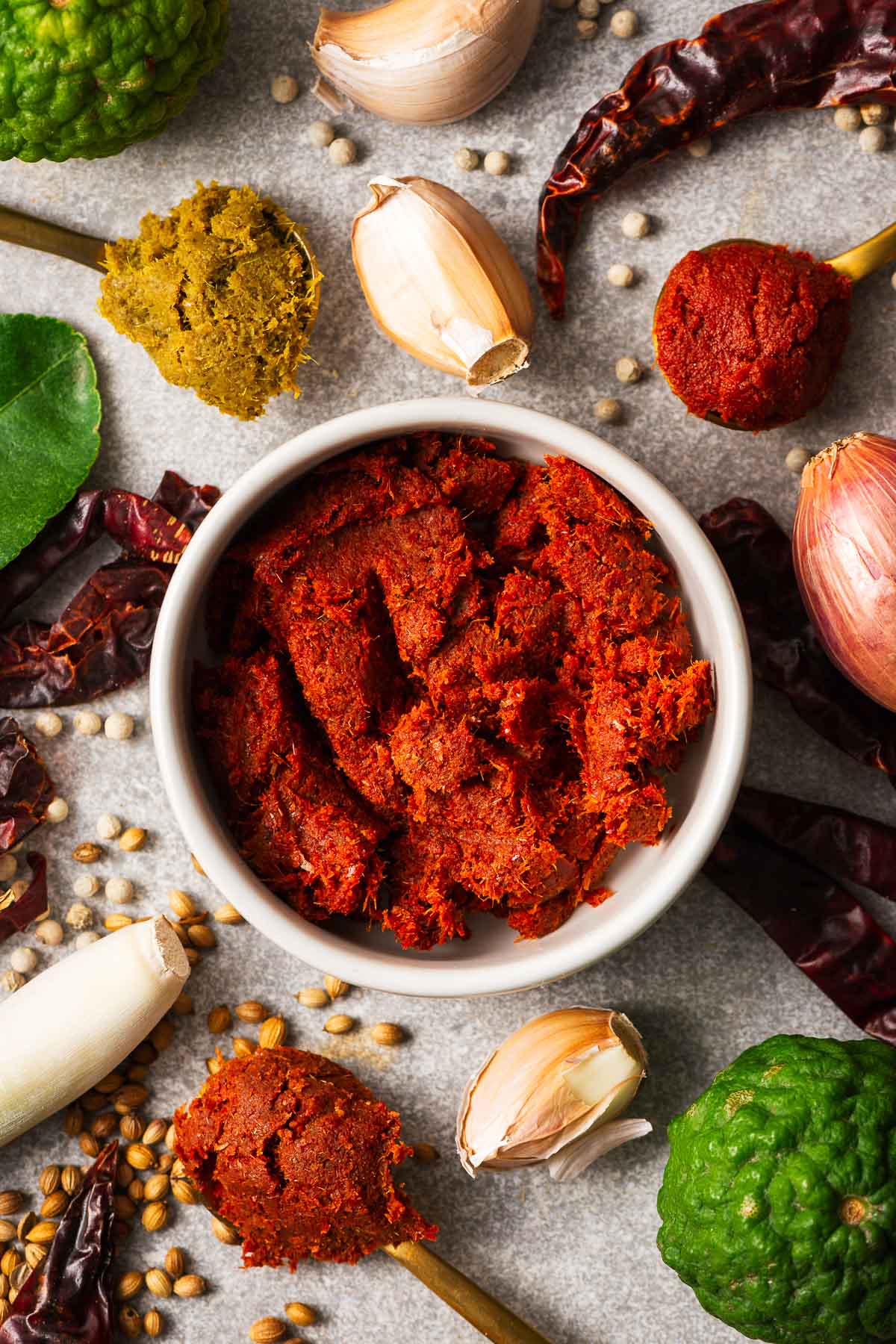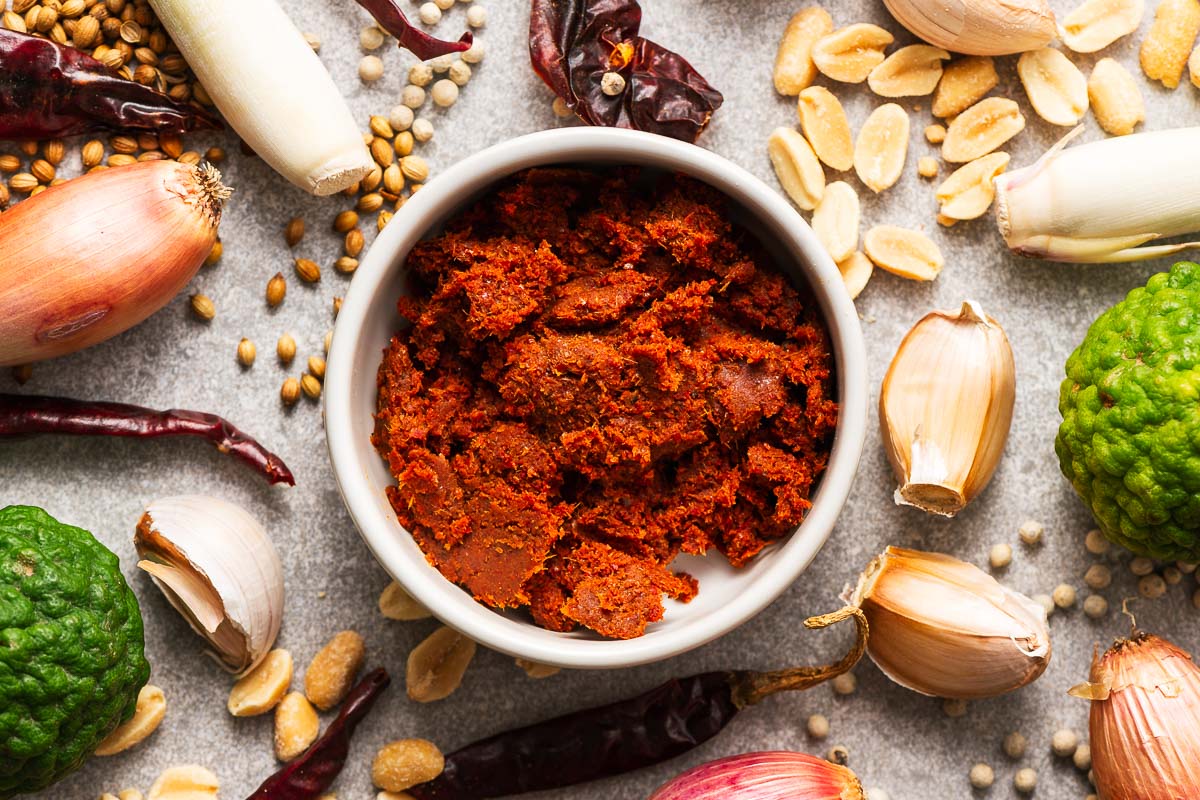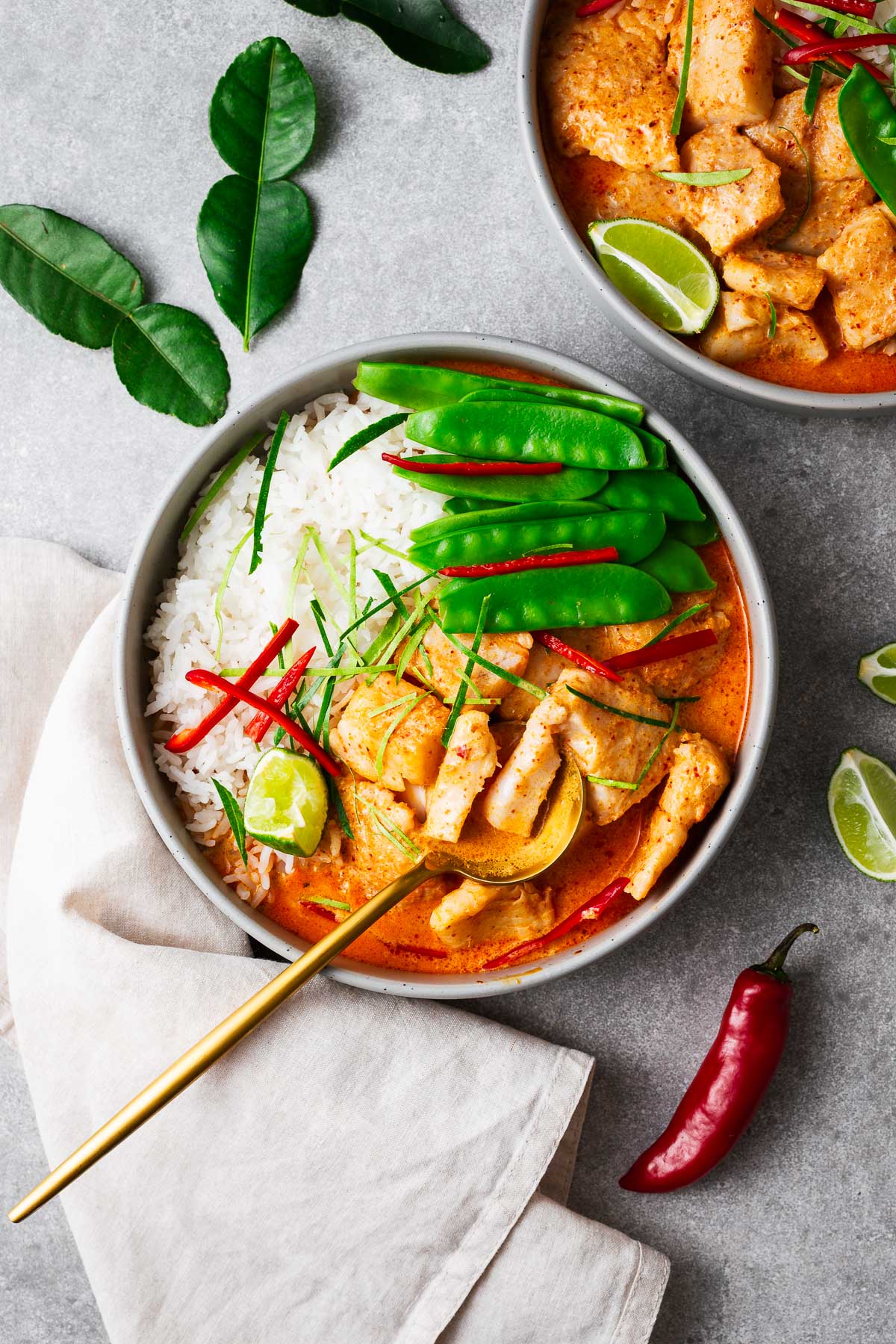The Best Thai Red Curry Paste Substitutes (+ What To Avoid)
I taste-tested my way through the best Thai red curry paste substitutes. From different types of curry paste to homemade red curry paste and simple customisable spice blends, I have the best alternative to suit your pantry and palate.

Looking for the best Thai red curry paste substitute? You’re not alone! Thai curry pastes are essential ingredients in many delicious Thai dishes.
If you love Thai food as much as I do, you might panic if you run out. But don’t worry, I’ll have you cooking your favourite Thai dishes in no time.
Whether you prefer a homemade red curry paste, a store-bought option like other Thai curry pastes, or a DIY substitute blend like chilli garlic sauce and shrimp paste, I have a Thai red curry paste alternative for everyone. From spicy to mild or vegan, you’ll find the best substitutes for Thai red curry paste to suit your pantry.
1. Homemade curry paste

Did you know how easy it is to make Thai red curry paste at home?
Authentic Thai red curry paste (known as prik gaeng ped) contains ingredients like dried red chillies, cilantro roots, lemongrass, kaffir lime zest (makrut lime zest), garlic cloves, shallots, galangal, shrimp paste, white peppercorns, and sea salt. It can also contain cumin seeds or coriander seeds.
The exact ingredients differ between recipes and curry paste brands.
To make homemade curry paste, simply rehydrate the dried chillies, then use a small food processor to blend all the ingredients together into a smooth paste.
The best thing about making your own curry paste? You can adjust the heat level to your liking.
And, even if you don’t have all the different ingredients, making homemade Thai red curry paste and skipping the ingredients you don’t have is the best possible Thai red curry substitute. And for a vegan red curry paste, replace the shrimp paste with miso paste.
Try this homemade Thai red curry paste recipe.
2. Green curry paste

Thai green curry paste is a fantastic substitute for red curry paste. Unlike the red curry pastes, it contains fresh green chillies, which gives it a unique flavour and a vibrant green colour. It can also contain more kaffir lime peel and turmeric powder.
The flavour of green curry paste is not too far from that of red curry paste, but the colour is obviously very different. Just embrace this and make green curry!
To use green curry paste as a substitute for red Thai curry paste, follow the same measurements called for in the red curry recipe.
Try this easy five-ingredient Thai green curry!
3. Yellow curry paste

Thai yellow curry paste is another great substitute for red curry paste. Most store-bought Thai yellow curry pastes are vegan and gluten-free, making it an excellent alternative for those with dietary restrictions.
The main difference between yellow and red curry paste is the lack of shrimp paste and the addition of curry powder and spices like turmeric, cinnamon, cardamom and nutmeg.
Yellow curry paste works well as a substitute for red curry paste. However, if you want a more authentic flavour, add some shrimp paste (or vegetarian fish sauce). Simply use the same amount as the recipe calls for in Thai red curry paste.
4. Massaman curry paste

Massaman curry paste is very similar to Thai red curry paste. It has the same key ingredients but with the addition of spices like cinnamon, cardamom, cloves, coriander and cumin.
However, Thai red curry paste is spicier than Massaman paste whereas Massaman can have a stronger citrusy lemongrass flavour.
To use Massaman curry paste as a substitute for Thai red curry paste, start by using the amount called for in the recipe. Since Massaman curry paste is not as spicy as red Thai curry paste, you may want to add more Massaman curry paste, extra red chillis or chilli flakes for heat.
5. Panang curry paste

Panang curry paste is a popular ingredient in Thai cuisine known for its rich and complex spicy flavour profile. It’s not as widely available as red curry paste, so if you can’t find Thai red curry paste in your local grocery store, you probably won’t find panang curry paste either.
That said, panang curry paste makes a great substitute for Thai red curry paste if you happen to have it on hand.
The paste is made from a similar blend of aromatic spices and herbs, such as lemongrass, galangal, and kaffir lime leaves. But it also contains ground peanuts or mung beans for that distinctive earthy flavour.
To use panang curry paste as a substitute for Thai red curry paste, use the same amount called for in the recipe if you’re a fan of spicy curries. Or, if you prefer milder curries, use a little less than the recommended amount. You can always add a teaspoon of ground red chilli powder for an extra kick
6. Indian curry paste
Indian curry paste is a decent substitute for red Thai curry paste if you’re in a pinch. While it may have a different flavour profile thanks to the tomato paste, vinegar, and different spices, it still has a similar level of heat and complexity.
You can boost the Thai curry flavours by adding kaffir lime leaves and Thai fish sauce to your simmering curry sauce.
To use Indian curry paste as a substitute for Thai red curry paste, replace the red curry paste with an equal amount of Indian curry paste. Keep in mind that the final flavour may vary depending on the brand and type of curry paste used. Then, add a few fresh kaffir lime leaves (frozen also works).
Adjust your curry to taste with a splash of fish sauce and a pinch of brown sugar.
7. Chilli garlic sauce
Chinese chilli garlic sauce is a versatile condiment – I highly recommend always having a jar on hand, it makes a great substitute base for many other Asian condiments. Different varieties are widely available in local and speciality Asian grocery stores.
The simple sauce lacks the complexity of Thai red curry paste, but with a few tweaks, you can turn it into an easy substitute for Thai red curry paste.
It contains red chilli peppers, garlic, vinegar, sugar and salt. This covers the spicy, garlicky flavour profile of red curry paste.
To use chilli garlic sauce as a substitute for Thai red curry paste, mix:
- 2 teaspoons chilli garlic sauce,
- 1 teaspoon shrimp paste (or fish sauce), with
- 2 teaspoons kaffir lime zest (from one lime).
8. Gochujang paste

Gochujang is a spicy Korean fermented paste. It has an intensely savoury, sweet, spicy, and almost smoky taste packed with umami.
On its own, it lacks the citrusy flavours of curry paste. But you can use gochujang as a vegan substitute for Thai red curry paste if you add some ginger, garlic and lime zest.
To make a red curry paste substitute from gochujang, mix three teaspoons of gochujang paste with one teaspoon of grated garlic, one teaspoon of grated ginger and one teaspoon of lime zest.
9. Chilli paste
Thai chilli paste, also chilli jam or nam prik pao, is a paste made from Thai chillies, shrimp paste, dried shrimp, tangy tamarind, palm sugar, and a few more ingredients. It can make a suitable substitute for Thai red curry paste.
However, Thai chilli paste lacks the citrusy kaffir lime and lemongrass flavour of curry paste and is much sweeter with a slight acidic tang. And, Thai chilli paste is very sweet.
To use Thai chilli paste as a substitute for Thai red curry paste, don’t stir-fry the paste in oil at the start of the recipe – the sugar will burn. Instead, stir it into your curry sauce towards the end. And, for a closer flavour match, also add some makrut lime leaves to the simmering sauce.
And, to use another type of chilli paste (like sambal oelek) as a red curry paste alternative, add more Thai flavour like kaffir lime, lemongrass and shrimp paste. See the next section for ideas on how to adapt chillies using ingredients you may already have at home.
10. Chillies

If you have none of these substitutes available, you can recreate the heat with chillies. Or, even better, create a blend with chillies as the key ingredient, to introduce some of the Thai flavours.
Use a combination of ingredients that you have at home to create a spicy, garlicky, citrusy, umami-packed paste to substitute Thai red curry paste:
- Chillies: Rehydrated dried chillies, fresh thinly sliced chillies, chilli flakes, or chilli powder
- Garlic: Fresh garlic cloves (grated or finely diced) and/or shallots
- Citrus: Lemongrass (outer leaves removed, core thinly sliced), lime zest, lime leaves, lime juice, or (in a pinch) lemon zest
- Umami: Shrimp paste, fish sauce, soy sauce, or miso paste (vegan alternative)
Avoid these Thai red curry paste substitutes
Tomato paste: I often see tomato paste recommended as a red curry paste substitute. But the flavours are worlds apart. Instead, if you’re looking for a non-spicy alternative, blitz red bell peppers with garlic, ginger, lime zest and shrimp paste.
Instead, for the best non-spicy substitute, make Thai red curry paste using red bell pepper instead of chillies. Use as many of the remaining ingredients as you have.
Curry powder: Aside from spiciness, Indian curry powder has none of the Thai red curry paste characteristics. Sure, you can swap red curry paste for curry powder – the resulting dish may even be delicious. But it will have none of the intended Thai flavours.
Instead, for the simplest homemade red curry paste substitute, mix four teaspoons of thinly sliced red chillies, two teaspoons of diced (or grated) garlic, two teaspoons of grated ginger, and one teaspoon of fish sauce to substitute the paste. Then, add two sprigs of kaffir lime leaves to the cooking sauce.
Frequently asked questions
If you do not have Thai red curry paste, you can use a different Thai curry paste like Massaman curry paste. Or create a homemade substitute by combining chilli, garlic, ginger, lemon zest and shrimp paste.
While you can add a few ingredients to use gochujang as a substitute for Thai red curry paste, red curry paste does not make a good substitute for gochujang. The major differences are the citrus and fermented shrimp flavours in Thai red curry paste.
No, Thai chilli paste is a sweet and spicy condiment made from pounded red chillies, shrimp paste, dried shrimp, palm sugar, and a few more ingredients. It is used as a dip or added to dishes for an extra kick of heat. Red curry paste, on the other hand, is a base for making Thai curries and contains dried chillies, shrimp paste, lemongrass, kaffir lime peel, galangal, and a few more ingredients.
More about Thai red curry paste
Thai red curry paste is an essential ingredient in many Thai dishes. The traditional process involves pounding the ingredients together in a mortar and pestle into a smooth paste. Thankfully, today we can use a food processor for easy yet authentic homemade Thai curry paste!
Making red curry is super simple:
- Stir-fry the curry paste in oil.
- Add coconut milk, fish sauce, and palm sugar (or brown sugar).
- Cook your choice of protein (chicken, beef, fish, shrimp, tofu), and vegetables (like red bell peppers, bamboo shoots, or eggplant) in the curry sauce.
- Serve over jasmine rice for a complete Thai meal.
Why not try a homemade Thai curry?
- Easy Thai red curry recipe with fish (or use your preferred protein)
- Simple five-ingredient Thai green curry


